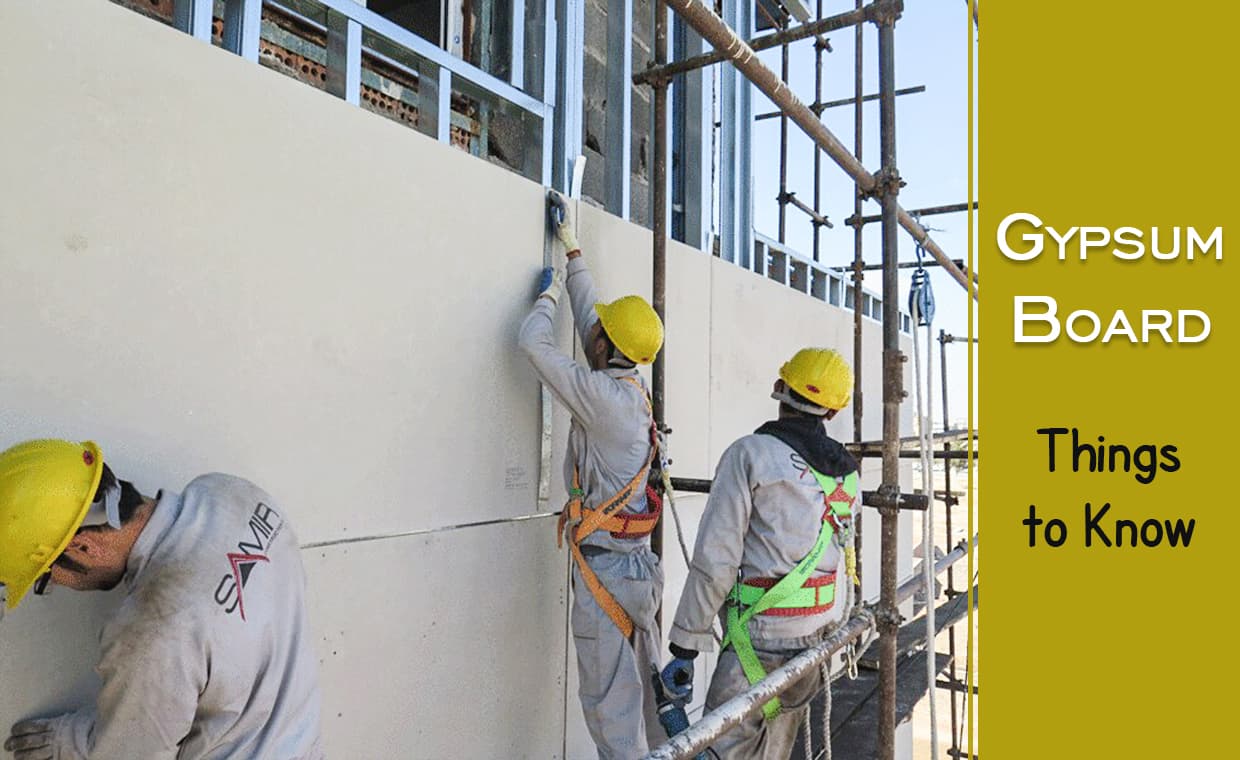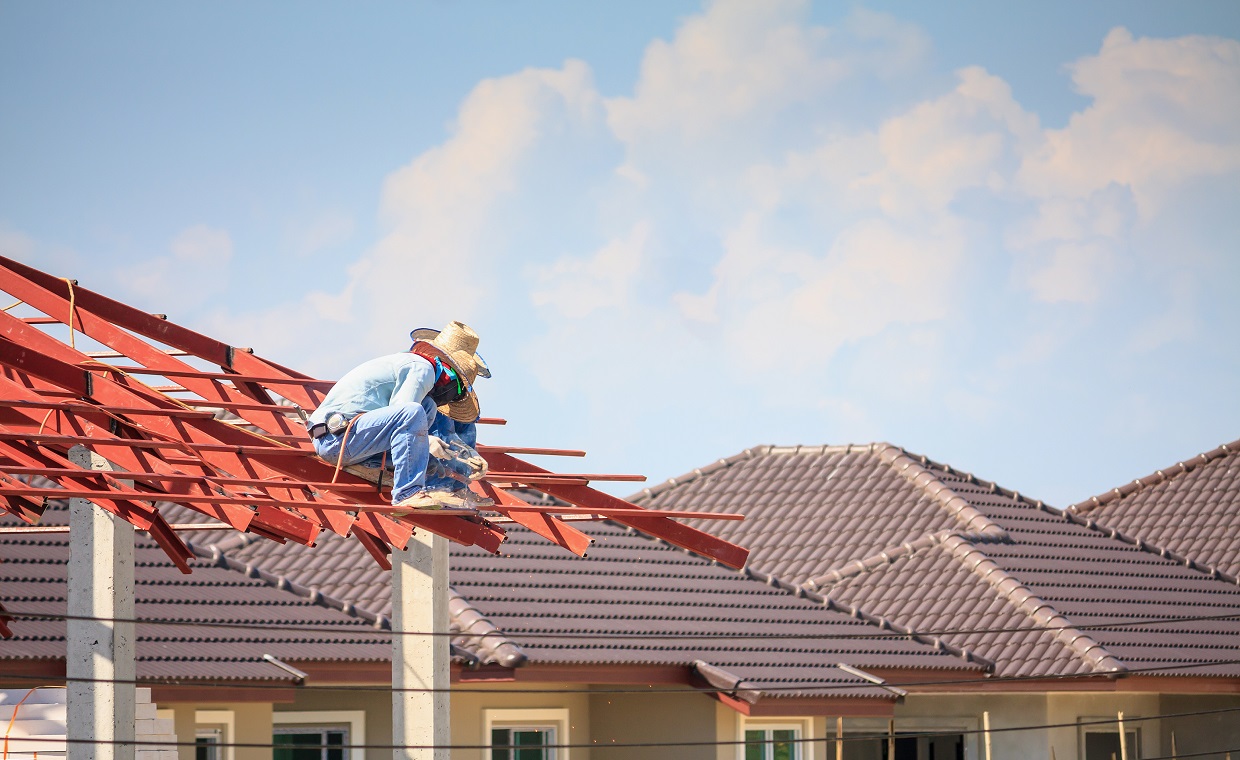
The home-building and remodelling industry is witness to a variety of construction materials used to enhance the functionality and attractive appeal of a building. One such product is gypsum board.
Wondering, what is a gypsum board? Well, this post will offer knowledge about gypsum board design and types and their significance in the home-building segment.
Gypsum board is the generic name for a family of panel products. These comprise of a non-combustible core made of gypsum and a paper surfacing on the face, back, and long edges. The different types of gypsum boards used in building and construction are collectively termed as “gypsum panel products.” All types of gypsum board products contain a gypsum core; however, their surface can be wrapped with a variety of materials, such as paper and fibreglass mats.
Gypsum boards are often called drywall, wallboard, or plasterboard. Owing to their non-combustible core and paper facers, they differ from other panel-type sheds road and building products, such as plywood, hardboard, and fiberboard. When their joints and fastener heads are covered with a joint compound system, gypsum wallboard creates a continuous surface suitable for a variety of interior designing projects, both residential and commercial.

Gypsum Wallboard Showing Joints and Framing
Types of Gypsum Board
The manufacturers of gypsum boards offer a wide variety of gypsum board products for specific applications. These boards can be used for the surface layer of interior walls and ceilings, a base for ceramic, plastic and metal tile, exterior sheathing and soffits, elevator and other shaft enclosures, area separation firewalls between rooms, and the fire-resistant layer over structural elements.
01. Regular and Type X Gypsum Board
You will find a variety of gypsum board thicknesses and each is used for specific purposes:

Gypsum Board on Horizontal Wall
- 1/4 – inch (0.635 cm) – A low-cost gypsum board used as a base in a multilayer application for improving sound control, used to cover existing walls and ceilings in remodelling and for curved surfaces. Generally, a gypsum ceiling board is an ideal choice for home décor.
- 3/8 – inch (0.9525 cm) – A gypsum board principally applied in a double-layer system over wood framing and as a face layer in repair or remodelling projects.
- 1/2 – inch (1.27 cm) – Generally used as a single layer wall and ceiling material in residential work and in double-layer systems for greater sound and fire ratings.
- 5/8 – inch (1.5875 cm) – Used in quality single-layer and double-layer wall systems. A greater gypsum board thickness provides additional fire resistance, improved rigidity, and better impact resistance.
- 3/4 – inch & 1 inch (1.905 cm & 2.54 cm) – They are used in the interior decor as a gypsum board partition, shaft wall, stairwell, chase way, area separation firewall, and corridor ceiling. In some interior partitions, special-edged panels are used.

Apply Gypsum Board on Vertical Face
Standard size gypsum boards are 121.92cm (48-inches) wide and 8, 10, 12, or 14-feet long. The 121.92cm (48-inch) width is compatible with standard framing methods in which studs or joists are spaced at 16 inches and 24 inches (60.96cm). Customised gypsum boards are easily available with its manufacturers.
02. Types of Gypsum Board Based on Edges
- Edges available are rounded, tapered, bevelled, square-edged, and tongue & groove (V-edge). The square and tapered-edged board are the most common and easily available in the market. Bevelled and round-edge boards can be produced on demand.

Gysum Board Edge Types
03. Common Types of Gypsum Board
(a) Regular/Standard Gypsum Board
- It is covered with ivory cardboard on its facing side, grey cardboard on the backside, and blue colour tape on the edges. This gypsum wall is used as a covering material for walls, ceilings, and partition walls. This type of gypsum board is ideal for gypsum false ceilings.

Gypsum Board on False Ceiling
(b) Fire Resistance Gypsum Board
- It is covered with pink cardboard on the face side, pink or grey cardboard on the backside and red colour tape on the edges. This is used as covering material for interior walls. Gypsum ceilings are employed in residential as well as commercial spaces that require specific fire-rated assemblies. These are ideal for ceiling & drywall where fire protection is a priority.

Fire Resistant Gypsum Board
(c) Moisture-Resistant Gypsum Board
- It is covered with green cardboard on the ace side, grey cardboard on the backside, and green colour tape on the edges.
- It is used as a covering material for interior walls.
- Gypsum ceilings have residential as well as commercial applications that require specific moisture or water-rated assemblies.
- This is ideal for ceilings and drywall partitions and can be used as a base for tiles installation in wet areas like bathrooms, kitchens, and external soffits in sheltered positions.

Moisture Resistant Gypsum Board
(d) Fire and Moisture-Resistant Gypsum Board
- It is covered with green cardboard on the face and the backside and black tape on the edges.
- It is used as a covering material for interior walls and ceilings of residential and commercial buildings that require specific fire or moisture-rated assemblies.
- It is generally used as a drywall partition and for the protection of structural steel elements.

Gypsum Board as Drywall Partition and Protection of Structural Steel Elements
(e) Abuse-Resistant Gypsum Panels
- It offers greater resistance to surface indentation, abrasion, and penetration than standard gypsum panels.

Abuse Resistant Gypsum Wall
(f) Exterior Gypsum Soffit Board
- This gypsum board is designed for outdoor applications. It is used on the undersides of eaves, canopies, carports, and other commercial and residential exterior areas with indirect exposure to the weather.
- Soffit board is available in 1/2 or 5/8 -inch thicknesses, having both regular and Type X core.

Exterior Gypsum Soffit Board
(g) Foil-Backed Gypsum Board
- It has aluminium foil laminated to the back surface of a regular gypsum board or other gypsum panel products. Foil-backed panels serve as vapour barriers.

Foil Backed Gypsum Wall
(h) Gypsum Liner Board
- It serves as a liner panel in shaft walls, stairwells, chase ways, area-separation firewalls, and corridor ceilings.
- It has a special fire-resistant core encased in moisture-resistant paper.
- Liner board is available in ¾ or 1-inch thicknesses, widths of 24 or 48 inches, and with square edges (sometimes eased square edges).
- Gypsum liner board is also available with fibreglass mat facing which increases its weather and mould resistance.

Shaft Wall Gypsum Board
(i) Gypsum Sheathing
- It is used as a protective fire-resistant membrane under exterior wall-surfacing materials such as wood siding, masonry veneer, stucco, and shingles.
- It also provides protection against the passage of water and wind and adds structural rigidity to the framing system. The non-combustible core is surfaced with water-repellent paper. In addition, it may also have a water-resistant core.
- Gypsum sheathing is available in 2 feet and 4 feet widths and ½ -inch and 5/8 -inch thickness.
- It is also available with Type X core and glass mat facing.
- This product is more weather and mould-resistant than paper-faced gypsum sheathing. It is often used as a substrate for Exterior Insulating Finishing Systems (EIFS).

Gypsum Sheathing
(j) Impact-Resistant Gypsum Panels
- They offer greater resistance to the impact of solid objects from high traffic and vandalism than standard gypsum panels.

Impact Resistance Gypsum Panel
(k) Sag-Resistant Board
- It is a ceiling panel that offers greater resistance to sagging than regular gypsum products used for ceilings where framing is typically spaced at 24 inches.

Sag Resistant Gypsum Board
(l) Type C or Proprietary Type-X Gypsum Board
- It is available in ½ -inch and 5/8 -inch thicknesses. These boards are needed in some fire-rated assemblies. Additional additives give this product improved fire resistance.

Type C Gypsum Board
(m) Water-Resistant Gypsum Board
- It has a water-resistant gypsum core and a water-repellent paper. It serves as a base for a ceramic or plastic wall tile or plastic finish panels in dry areas. This product is available with a regular or Type X core and in ½ -inch and 5/8 -inch thicknesses.
Conclusion:
The above-listed boards cover all the types of gypsum boards available in the market. They have varying physical and chemical properties that make them suitable for specific applications. We hope this article has offered you the knowledge you were looking for. This information will help you choose a suitable gypsum board design and type for your next home-refurbishment project.
If you want to share your ideas and views in various types of gypsum boards, please do so by commenting in the space given below.Don’t forget to watch whiteboard animation video below.
We have discussed uses, types and thicknesses of gypsum board in it.
Must Read:
All You Need to Know about GFRG Panel in Building Construction!
Best Materials of Wall Panels for Decorating your Rooms!
Image Courtesy: Image 3, Image 4, Image 10, Image 11, Image 13































